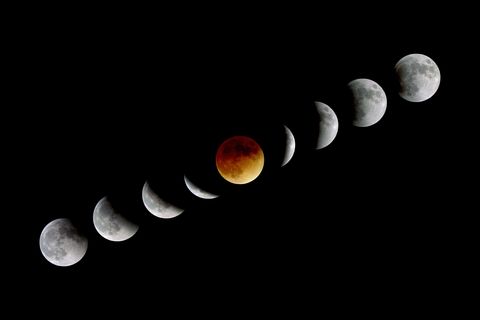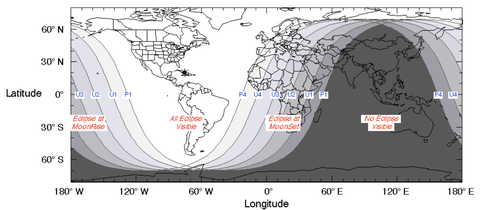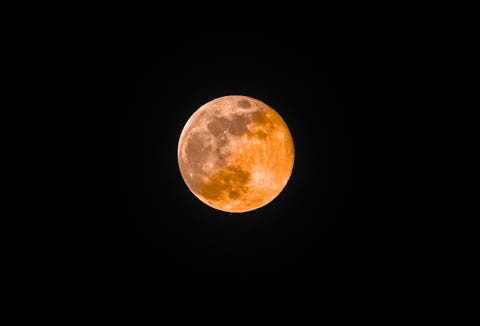Everything To Know About the January 2019 Lunar Eclipse
The shadow of the Earth will eclipse the moon and turn it blood red on January 21, 2019.
By John Wenz
GETTY IMAGESDR FRED ESPENAK/SCIENCE PHOTO LIBRARY
The next big chance for Americans to ooh and ahh at the sky happens on January 21, 2019. For just over an hour, the moon will turn an eerie red. This total lunar eclipse should be visible everywhere in the U.S. but Hawaii, and people there should see a pretty good partial eclipse.
Here’s what you need to know:
How Does a Lunar Eclipse Work?
The Great American Eclipse so many people witnessed in August 2017 was a total solar eclipse, in which the moon moves between the Earth and the sun in such a way as to block out our star. The upcoming event on Jan. 21, 2019 is a total lunar eclipse. In this case, the Earth will come between the sun and the moon in just the right way so that the shadow of our planet is cast entirely cast across the moon.
The moon has to be in just the right place in its orbit for this to happen—essentially in opposition. (Though astronomers might shudder at such a use of a term for when planets are aligned just right from the sun, the Earth, and the moon are essentially in a straight line.)
Where Will It Be Visible?

Eclipse visibility 2019.
WIKIMEDIA COMMONS / PIRULITON
All of North America, all of South America, and a few areas of Western Europe and Africa will be able to see a total eclipse. The European arc essentially goes up through Portugal and Spain, through a small part of France, encompasses all of the United Kingdom, and then continues on into the Scandinavian countries. Mauritania and Western Sahara will be the only African countries to see the total eclipse.
Still, all of Africa save for Madagascar will see at least a partial eclipse, and areas from the Middle East to about half of Afghanistan should see something. Much of Asia will miss out because the event will take place during daylight hours there when the moon is not visible.
When Does It Start?
You’ll want to stay up late and be patient. The wind-up to the eclipse is long, starting at about 10:36 p.m. Eastern on January 20 when the first hints of the eclipse will start to hit the moon. This is called the penumbral eclipse, and involves a slight darkening of the moon’s surface in preparation for the rest of the total eclipse. The first portion of the partial eclipse phase will begin less than an hour later, at 11:33 p.m. The total eclipse phase will begin at 12:41 a.m. on January 21.
The Moon will be in a total eclipse for a little more than an hour, turning an orange-red thanks to the shadow cast by the Earth. It will reach “maximum eclipse” at 1:12 a.m. Eastern before ending at 1:43 a.m. It will then enter another partial phase, lasting until 2:50 a.m. If you’re still up at this point, the last shadows will leave the moon at 3:48 a.m.
This is a school and a work night so unless you have a cool boss, you probably shouldn’t stay up much past maximum eclipse. (A note to our international readers: Eastern time in the United States is four hours behind Coordinated Universal Time.)

The red shadow of an eclipse.
GETTY IMAGESPIERRE LONGNUS
So Why Is It Red?
The light coming through Earth is heavily filtered, with our atmosphere taking much of the brunt of filtering the light hitting the day side. When it gets to the thickest parts of the atmosphere, only the red band is “long” enough to make it through, with yellow and blue absorbing into the atmosphere. This effect gives the moon its reddish tint during an eclipse.
What Do I Need To See It?
Staring at the moon is not like staring at the sun. You can … actually do it. For a simple explanation why, here’s Astronomy Magazine’s senior editor Michael Bakich:
“The moon is always safe to look at because, just like objects here on Earth, we see it because it reflects sunlight. During an eclipse, the moon is in Earth’s shadow, so there’s even less light coming from it. So, yes, it's perfectly safe.”
You can even bust out the binoculars or telescope for a lunar eclipse, though you may want a telescope filter for the brighter eclipse areas. Don’t worry—they’re less like putting welding glass over your telescope and more like a pair of sunglasses, moderately dimming some of the light.
Is the Eclipse Different Than a Blood Moon?
Not really, but that term, as metal as it sounds, comes from astrologers and conspiracy theorists. Everyone uses the term, but it doesn’t mean anything scientifically.
No comments:
Post a Comment